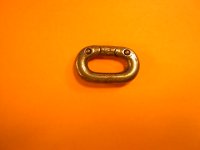Greetings Fellow Brats,
Went out to the beach today and had a cluster when my windlas jammed when I tried to retrieve the anchor. Its a Lewmar 700, and its not the first time its happened. Seems where the rope attaches to the chain there is always a problem feeding thru the windlas down thru the deck. It bunches up and jams so I have to go forward and deal with it.
I have 25 feet of 1/4 inch chain and would like to add another 25 feet to avoid the problem in shallow anchoring. My question is how do I connect another 25 feet of chain? I just looked on the West Marine site and didnt see anything. It would have to be a connector that is strong and will feed thru the windlas. Does anyone know what I could use? I hate to just buy 50 feet of new chain.
Thanks for any ideas.
Bill and Beth
Went out to the beach today and had a cluster when my windlas jammed when I tried to retrieve the anchor. Its a Lewmar 700, and its not the first time its happened. Seems where the rope attaches to the chain there is always a problem feeding thru the windlas down thru the deck. It bunches up and jams so I have to go forward and deal with it.
I have 25 feet of 1/4 inch chain and would like to add another 25 feet to avoid the problem in shallow anchoring. My question is how do I connect another 25 feet of chain? I just looked on the West Marine site and didnt see anything. It would have to be a connector that is strong and will feed thru the windlas. Does anyone know what I could use? I hate to just buy 50 feet of new chain.
Thanks for any ideas.
Bill and Beth


